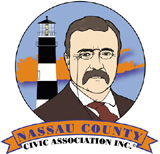NASSAU COUNTY CIVIC ASSOCIATION, INC.
"The government is us, we are the government, you and I." Teddy Roosevelt

|
NASSAU COUNTY CIVIC ASSOCIATION, INC. "The government is us, we are the government, you and I." Teddy Roosevelt |
 |
|
It's
possible to control costs and improve educational quality By Robert B. Ward |
|
School boards and superintendents who asked voters to approve tax hikes of two, three or four times the inflation rate defend their work with the argument that they simply had no way to avoid big spending increases. With state aid down slightly from last year, the only way to make up the difference is yet another round of local tax increases, they say. A closer look shows, though, that some school districts manage their costs better than others. By doing so, these districts keep taxes in line.
Take, for instance, the Ravena-Coeymans-Selkirk school district. RCS schools serve some 2,400 students in a largely rural area south of Albany. The district faces real challenges. Typical family incomes are relatively low. And many kids need extra help to succeed; the proportion of school-age residents classified as disabled is a third above the statewide average.
RCS teachers and administrators have been working hard to improve student achievement. And they're getting results. Scores on 8th-grade math tests were among the most improved in the state from 2000 to 2002, according to the state Education Department. The proportion of graduates earning a Regents diploma in 2002 was 62 percent, up from 48 percent two years earlier.
Knowing money would be tight this year, these school leaders identified key programs that had to be protected-or might even be expanded. Pre-kindergarten was one; a new honors math program another. In response to parent requests, the district is expanding kindergarten to a full day.
Like most other school districts, RCS also faced sharp increases in expenses for employee benefits this year. Health-insurance premiums will jump 20 percent or so, and retirement contributions will more than double. How to balance those costs with the need to improve education?
In most school districts, the answer was more spending, and more taxes. Districts outside New York and the four other largest cities raised per-pupil spending by 4.1 percent, far above the inflation rate. To pay for higher spending, districts imposed tax increases averaging 7.4 percent per student.
RCS administrators and school-board members took a different approach. They held spending flat. Considering a small increase in projected enrollment, per-pupil spending will actually go down slightly. The key to their success? Careful fiscal management. School districts often find that contracting for bus service is less costly than providing such service in-house, and RCS had operated that way for years. Recognizing that leased school buses are now relatively affordable, district administrators found that a change could save roughly $500,000, or 20 percent of the transportation budget. More aggressive bidding brought in lower costs for supplies ranging from fuel to copy paper. An early-retirement incentive reduced teaching costs. The district saves an average of 40 percent on many textbooks by buying reconditioned copies that are barely distinguishable from new.
Controlling spending allowed RCS to adopt a budget with a projected tax-levy increase of 2.5 percent, among the lowest in its region. The school board may use some of the additional state aid provided by the state Legislature to reduce that increase when it sets tax rates in August.
It's too late for other school districts to emulate RCS' good example this year. But now is a perfect time for all school boards and administrators to start solving the problems they will face in 2004.
Governor Pataki's Budget Division projects a $6 billion budget gap for the state next year - meaning school districts will not be able to count on more aid from Albany. Continued increases in some major costs, such as health insurance, are guaranteed.
School leaders have two choices. They can start scrutinizing every expense-payroll, benefits, transportation, textbooks, energy and so on. Or they can prepare yet another round of big tax increases on homeowners and businesses already hard-hit by a slow-growth economy, and already paying property taxes far higher than those in most states. Which will it be?
Robert B. Ward is director of research for The Public Policy Institute, the research affiliate of The Business Council of New York State. Based in Albany, The Institute conducts research and analysis on a range of public-policy questions of interest to New York's business community. E-mail: Bob.Ward@bcnys.org -- June 2003 |
|
The Public Policy Institute • 152 Washington Avenue • Albany,
NY 12210-2289
Re-printed with permission from The Public Policy Institute of New York State, Inc |
December 6, 2003